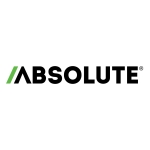
New Research From Absolute Software Reveals Increases in Device Mobility, Complexity, and Vulnerability With Widespread Adoption of Digital Learning
Findings examine key trends in K-12 device visibility, management, and security leaving schools at heightened risk of ransomware attacks
VANCOUVER, British Columbia & SAN JOSE, Calif.–(BUSINESS WIRE)–Absolute Software™ (NASDAQ:ABST) (TSX:ABST), a leader in next generation Endpoint Resilience™ solutions, today announced new research revealing the significant management and security challenges faced by K-12 education IT teams with the rise in digital learning and widespread adoption of 1:1 device programs. The third annual Absolute Endpoint Risk Report: Education Edition, titled “Three key trends impacting K-12 IT and security,” underscores how increased device mobility and complexity are leaving schools increasingly vulnerable to security risks and potential attacks.
As devices quickly became the primary mode of learning and connection for students and staff, school districts raced to expand their fleets; Absolute’s data shows that the total number of devices deployed across K-12 environments increased 74 percent from 2019 to 2020. At the same time, the disruption caused by digital learning – and the flurry of new technologies needed to support it – opened up new potential attack vectors for cybercriminals. Schools are now the top target for ransomware attackers, according to the FBI, with 57 percent of all reported ransomware attacks in August and September 2020 targeting K-12 institutions.
The new ‘learn-from-anywhere’ dynamic underscores the critical need for complete visibility and control over all student and staff devices, especially when off the school network. Embedded in the firmware of over half a billion Windows devices, and extendable to Chrome OS and iOS, Absolute enables education IT teams with a permanent connection to all devices and delivers continuous visibility, control, and intelligence across devices, data, and applications.
“As devices quickly became the classroom over the past year and a half, education IT teams were tasked with redefining learning for the modern era – in addition to successfully navigating the device management and security challenges they were already facing,” said Christy Wyatt, President and CEO of Absolute Software. “In this new digital reality, the endpoint is now the edge and the primary attack surface for cybercriminals is actually in the hands of students and staff. The ability to see, manage, and protect every endpoint device – as well as the data and applications on those devices – is absolutely critical in ensuring students and staff remain safe, connected, and productive no matter where physical learning is actually taking place.”
Other key findings from the 2021-22 Absolute Endpoint Risk Report: Education Edition include:
Distance learning truly goes the distance: Absolute’s data shows that nearly half (47%) of K-12 devices in spring 2021 were located more than 25 miles from their school or district, compared to 27 percent in spring 2020, with 21 percent of devices registering more than 500 miles away.
Increased engagement comes with rise in ‘shadow education’: Students and faculty spent 60 percent of their time online actively utilizing educational resources in 2021, according to Absolute’s data. But, it also shows a rise in ‘shadow education,’ with 21 percent of online activity in 2021 taking place outside established and approved education sites.
More complexity means heightened vulnerability: Schools have deployed an average of 6.7 applications to facilitate online learning, according to Absolute’s data, which includes 5.4 security controls – such as VPN, anti-virus, or anti-malware – per device. Every new app deployed on an endpoint device increases the likelihood of collision or decay; only 53 percent of anti-virus applications analyzed by Absolute were found to be working effectively.
A full version of the report, “Three key trends impacting K-12 IT and security,” is available for download here. To learn why more than 10,000 schools and districts rely on The Absolute Platform for Endpoint Resilience® to ensure complete visibility, control, and connectivity, visit www.absolute.com.
Methodology
This report analyzed anonymized data from Absolute-enabled devices across over 10,000 schools, as well as public data and information from trusted third-party sources. Absolute is committed to customer and student privacy and data protection; only anonymized, de-identified data was used in this study.
About Absolute Software
Absolute Software is a leader in next generation Endpoint Resilience solutions, delivering a unique security platform that unites the power of self-healing devices, applications, and network connectivity. Absolute is the only endpoint security provider embedded in more than half a billion devices that offers a permanent digital connection to see, manage, secure, and automatically heal every device, and provides deep insights into the health of devices, applications, and network connections. We empower customers with the critical capabilities required in a zero-trust world — enabling them to achieve a secure employee experience, a more effective IT department and a more secure organization in the work from anywhere era.
©2021 Absolute Software Corporation. All rights reserved. ABSOLUTE and the ABSOLUTE logo are registered trademarks of Absolute Software Corporation in the United States and/or other countries. Other names or logos mentioned herein may be the trademarks of Absolute or their respective owners. The absence of the symbols ™ and ® in proximity to each trademark, or at all, herein is not a disclaimer of ownership of the related trademark.
Contacts
Media Relations
Becki Levine, Absolute Software
press@absolute.com
858-524-9443
Investor Relations
Joo-Hun Kim, MKR Group
IR@absolute.com
212-868-6760
